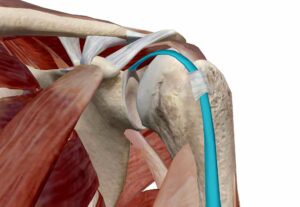Tendinitis bicipital is a condition that affects the shoulder and elbow. It causes pain and inflammation in the tendons that attach the biceps muscle to the shoulder and elbow. The most common symptom of tendinitis bicipital is a pain in the front of the shoulder or elbow. In this blog post, we will discuss what causes tendinitis bicipital, how to treat it, and some preventative measures you can take to reduce your risk of developing this condition.
Contents
What Is Tendinitis Bicipital?
 Tendinitis bicipital is a condition that results when the tendons in the shoulder become inflamed. The condition is also commonly referred to as a swimmer’s shoulder or pitcher’s shoulder. The condition is most common in young athletes, particularly those who participate in overhead-throwing sports, such as baseball or football.
Tendinitis bicipital is a condition that results when the tendons in the shoulder become inflamed. The condition is also commonly referred to as a swimmer’s shoulder or pitcher’s shoulder. The condition is most common in young athletes, particularly those who participate in overhead-throwing sports, such as baseball or football.
It is believed that the condition is caused by repetitive stress on the tendons and muscles of the shoulder. The condition can also be caused by a sudden injury to the area. There could be many possible causes of this condition, but the most likely one is overuse of the shoulder muscles.
You should be aware of the risk factors as well because that can increase your chance of developing the condition. The risk factors include:
- Participating in overhead-throwing sports
- Being a young athlete
- Having a previous injury to the shoulder
These can all lead to repetitive stress on the tendons and muscles, which can then lead to inflammation. Therefore, if you are involved in any of these activities, you should be sure to warm up properly and stretch before participating.
When Should You Seek Treatment?
It might be difficult to choose the right time when you need treatment for tendinitis bicipital. But here are some general guidelines. If the pain:
- is interfering with your daily activities
- has not improved after several days of self-care
- is accompanied by swelling, redness, or warmth in the affected area
- is accompanied by fever
Then it is time to seek medical help. Your doctor will ask you about your symptoms and medical history. He or she will also do a physical examination. This will help to rule out other conditions that may be causing your symptoms.
In addition, there are some warning signs that indicate you should seek medical attention right away. These include:
- unexplained weight loss
- night sweats
- a lump or mass in the affected area
- pain that gets worse with rest or at night
So, when you have any of these warning signs, be sure to see your doctor right away. They can diagnose and help you treat your condition. And further, they can provide you with the treatments that you need to get better.
What Are the Treatment Options?
 The good news is that most cases of tendinitis bicipital can be treated at home. And sometimes, there is a need for professional help. The treatments for bicipital tendinitis are designed to relieve pain and swelling and to help the tendon heal. Let’s discuss both types of treatment options for you in detail below:
The good news is that most cases of tendinitis bicipital can be treated at home. And sometimes, there is a need for professional help. The treatments for bicipital tendinitis are designed to relieve pain and swelling and to help the tendon heal. Let’s discuss both types of treatment options for you in detail below:
Home Treatments
There are several things you can do at home to treat your tendinitis bicipital. These include:
- Resting the affected arm: You need to give your tendon a chance to heal, and that means resting the affected arm. Avoid any activities that require you to use that arm, such as overhead motions, for at least a week. If the pain and swelling haven’t gone down after a week, it’s time to see a doctor.
- Applying ice: Ice can help reduce both pain and swelling. Apply an ice pack to the affected area for 15 minutes at a time, several times a day. You can try this home treatment for tendinitis bicipital for the first few days after your injury.
- Taking over-the-counter medications: Medications like ibuprofen and aspirin can help with the pain and swelling associated with tendinitis bicipital. Be sure to follow the instructions on the label carefully.
- Wearing a sling: A sling can help keep your arm in a position that takes the pressure off the tendon. For example, if you have bicipital tendinitis in your right arm, wearing a sling can help keep your arm close to your body. This will limit the amount of movement in your arm and give the tendon a chance to heal.
It is often believed that home treatments are sufficient to treat bicipital tendinitis. However, if you don’t see any improvement in your symptoms after a week, it’s time to see a doctor.
Professional Treatments
In some cases, home treatments aren’t enough to relieve the pain and swelling associated with tendinitis bicipital. When that happens, it’s time to see a doctor. Professional treatments for bicipital tendinitis include:
- Corticosteroid injections: These injections can help reduce inflammation and pain. It works by injecting a corticosteroid directly into the tendinitis bicipital. This will help reduce the swelling and pain.
- Physical therapy: A physical therapist can help you stretch and strengthen the muscles and tendons around your shoulder. This can help reduce the risk of further injury and also help relieve pain.
- Surgery: In some cases, surgery may be necessary to remove the damaged tendon. This is typically only done if other treatments haven’t worked. Surgery is often recommended for people who have had tendinitis bicipital for a long time and haven’t seen any improvement with other treatments.
If you think you may have tendinitis bicipital, it’s important to see a doctor. They can help you determine the best course of treatment.
No matter what treatment option you choose, it’s important to be patient. It can take weeks or even months for the pain and swelling to completely go away. But with time and proper treatment, you should be able to get back to your normal activities.
Can You Prevent Tendinitis Bicipital?
 It is not always possible to prevent tendinitis bicipital. Because the condition is often caused by overuse, you may be able to reduce your risk of developing the condition by:
It is not always possible to prevent tendinitis bicipital. Because the condition is often caused by overuse, you may be able to reduce your risk of developing the condition by:
- Taking breaks from activities that put a strain on your shoulder
- Using proper technique when participating in activities that may stress your shoulder
- Strengthening the muscles around your shoulder
- Avoiding sudden, jarring movements of your shoulder
- Increasing the flexibility of your shoulder muscles and tendons
These are some ways that you can prevent this condition. Tendinitis bicipital is a condition that causes pain and inflammation in the biceps tendon. It might not be easy to prevent, but there are treatments available to help manage the symptoms.
If you think you might have tendinitis bicipital, it is important to see a doctor so that you can get an accurate diagnosis and treatment plan. With the right treatment, you can reduce the pain and inflammation caused by this condition.
Conclusion
To conclude, tendinitis bicipital is a condition that results when the biceps tendon becomes inflamed. The condition can be quite painful and may limit your ability to move your arm. So, it is important to find the treatment that works best for you. There are a number of different treatment options available and your doctor can help you select the one that is right for you.
Therefore, you should see a doctor if you experience pain in your biceps tendon and find it difficult to move your arm. With proper treatment, you can soon find relief from the pain and get back to your normal activities.
Physical Therapy help patients recover from pain. If you’re experiencing Back pain, Shoulder pain, Knee pain, Neck pain, Elbow pain, Hip pain, or Arthritis pain, a physical therapist at MantraCare can help: Book a physiotherapy session.


